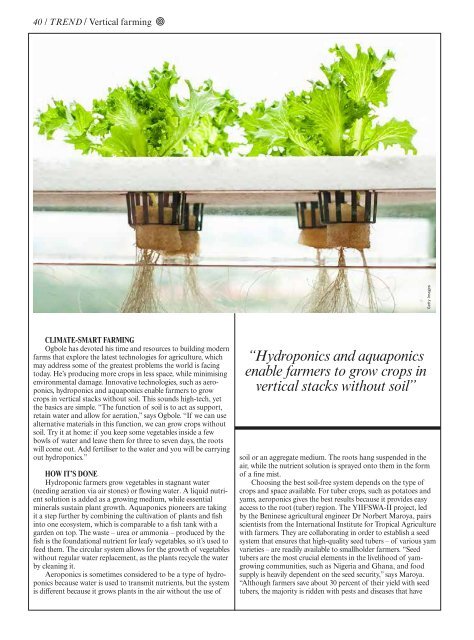january-2019
January Issue
January Issue
You also want an ePaper? Increase the reach of your titles
YUMPU automatically turns print PDFs into web optimized ePapers that Google loves.
40 / TREND / Vertical farming<br />
TREND / 41<br />
CLIMATE-SMART FARMING<br />
Ogbole has devoted his time and resources to building modern<br />
farms that explore the latest technologies for agriculture, which<br />
may address some of the greatest problems the world is facing<br />
today. He’s producing more crops in less space, while minimising<br />
environmental damage. Innovative technologies, such as aeroponics,<br />
hydroponics and aquaponics enable farmers to grow<br />
crops in vertical stacks without soil. This sounds high-tech, yet<br />
the basics are simple. “The function of soil is to act as support,<br />
retain water and allow for aeration,” says Ogbole. “If we can use<br />
alternative materials in this function, we can grow crops without<br />
soil. Try it at home: if you keep some vegetables inside a few<br />
bowls of water and leave them for three to seven days, the roots<br />
will come out. Add fertiliser to the water and you will be carrying<br />
out hydroponics.”<br />
HOW IT’S DONE<br />
Hydroponic farmers grow vegetables in stagnant water<br />
(needing aeration via air stones) or flowing water. A liquid nutrient<br />
solution is added as a growing medium, while essential<br />
minerals sustain plant growth. Aquaponics pioneers are taking<br />
it a step further by combining the cultivation of plants and fish<br />
into one ecosystem, which is comparable to a fish tank with a<br />
garden on top. The waste – urea or ammonia – produced by the<br />
fish is the foundational nutrient for leafy vegetables, so it’s used to<br />
feed them. The circular system allows for the growth of vegetables<br />
without regular water replacement, as the plants recycle the water<br />
by cleaning it.<br />
Aeroponics is sometimes considered to be a type of hydroponics<br />
because water is used to transmit nutrients, but the system<br />
is different because it grows plants in the air without the use of<br />
“Hydroponics and aquaponics<br />
enable farmers to grow crops in<br />
vertical stacks without soil”<br />
soil or an aggregate medium. The roots hang suspended in the<br />
air, while the nutrient solution is sprayed onto them in the form<br />
of a fine mist.<br />
Choosing the best soil-free system depends on the type of<br />
crops and space available. For tuber crops, such as potatoes and<br />
yams, aeroponics gives the best results because it provides easy<br />
access to the root (tuber) region. The YIIFSWA-II project, led<br />
by the Beninese agricultural engineer Dr Norbert Maroya, pairs<br />
scientists from the International Institute for Tropical Agriculture<br />
with farmers. They are collaborating in order to establish a seed<br />
system that ensures that high-quality seed tubers – of various yam<br />
varieties – are readily available to smallholder farmers. “Seed<br />
tubers are the most crucial elements in the livelihood of yamgrowing<br />
communities, such as Nigeria and Ghana, and food<br />
supply is heavily dependent on the seed security,” says Maroya.<br />
“Although farmers save about 30 percent of their yield with seed<br />
tubers, the majority is ridden with pests and diseases that have<br />
Getty Images<br />
accumulated in the tubers and soils.” Maroya and his team are<br />
using aeroponics to facilitate a rapid and safe multiplication<br />
of yam seed tubers. Their objective is to achieve a 30 percent<br />
increase in the productivity of yam cultivation for at least<br />
320,000 farmers in Ghana and Nigeria.<br />
MORE CROPS, LESS IMPACT<br />
“The hydroponic system supports the growing of all leafy<br />
vegetables, herbs, fruits and starchy foods,” says Peter Chege,<br />
entrepreneur and founder of Hydroponics Africa. Hydroponics<br />
and aquaponics are often considered a cost-intensive enterprise,<br />
but Chege is convinced that it doesn’t need to be. Over the<br />
years, the Kenyan entrepreneur has learned that many farmers<br />
incur high costs for animal feed even though the quality is often<br />
unsatisfactory. To address this problem, he and his team started<br />
developing hydroponic systems that enable farmers to grow<br />
animal feed at low cost, while also providing them with the<br />
means to grow vegetables.<br />
Evidently proud, Chege says, “Since 2015, we have been<br />
rolling out our simplified hydroponic systems, which are not<br />
only practical, but cost-effective too. We’ve developed an optimal<br />
nutrient solution specific to various crops, which directly irrigates<br />
the crop’s root through the watering system. This minimises wastage<br />
of both nutrients and water (excess water is being recycled).<br />
For the substrates, we use recycled materials, such as pumice,<br />
wood chips, mattress tissues and even plastic cups. The water<br />
system is fully automated and powered by integrated solar panels,<br />
and there is zero use of herbicides. As there is no competition<br />
for nutrients, the crops are highly nutritious compared to crops<br />
grown under conventional methods, and they mature 30 percent<br />
faster, resulting in more harvests per year.”<br />
EMERGING POTENTIAL<br />
The impact these new farming methods have on production<br />
is significant. “If you want to grow tomatoes in the soil, it will<br />
take you three months; with a hydroponic system it takes you,<br />
at most, a month. Growing wheatgrass in the soil takes three to<br />
four months, with this system it takes only seven days; without<br />
any pesticides, very little fertiliser and no soil,” says Ogbole in<br />
his TEDx Talk.<br />
Will these vertical, soil-free farms unleash a “green revolution”<br />
in Africa, as proponents love to call it? With just three major<br />
suppliers, hydroponics is still an emerging industry, but according<br />
to Chege, business is booming. So far Hypdroponics Africa has<br />
installed more than 5,000 hydroponic systems in Kenya, Uganda,<br />
Rwanda and Somalia, and the company has extended its presence<br />
in Burkina Faso and Nepal. Based on the current high demand,<br />
they expect an exponential growth of 70 percent in the next few<br />
years.<br />
Soil-free farming systems are inseparable from the global<br />
movement that seeks to make agriculture climate-smart and<br />
future-proof. Most governments now recognise the need to<br />
develop interventions, and some have already taken action.<br />
As one of the first in Sub-Saharan Africa, Kenya launched<br />
the Climate Smart Agriculture Strategy 2017–2026, in which<br />
the government declares its objective to make agriculture more<br />
sustainable and resilient through collaborations and education.<br />
“The major challenge is knowledge,” says Ogbole. “By<br />
training people and making them aware of the potential of<br />
vertical and soil-free farming, agriculture becomes a tool to<br />
build the nation we so much desire. I’m not saying we should<br />
eliminate soil, but I do believe we should complement soil.<br />
Vertical, soilless farming is one of the ways to ensure the<br />
future of food.”<br />
30<br />
Urban aeroponics gardens can grow in half<br />
the time it takes for them to grow in soil,<br />
with a yield of 30% more.<br />
90<br />
Aeroponic farming requires around 90%<br />
less water than soil-grown crops.<br />
6,400<br />
The biggest aeroponics farm in the world<br />
is being built in Newark, US, with 6,400 sq<br />
m of cultivated spaces without soil.<br />
8,000<br />
By using aeroponics, a farmer can produce<br />
up to 8,000 lettuce plants in a 3 m x 1 m<br />
space each year.<br />
50,000<br />
A yam tuber that is multiplied using<br />
aeroponics can get more than 50,000<br />
tubers annually.<br />
Peter Chege<br />
Sources: Environmental Assessment Agency PBL, International Institute for Tropical Agriculture (IITA), YIIFSWA-II project, IITA University of Chile 2015.
















